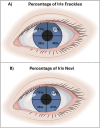Iris Pigmented Lesions: Unraveling the Genetic Basis of Iris Freckles and Nevi
- PMID: 40261663
- PMCID: PMC12020957
- DOI: 10.1167/iovs.66.4.62
Iris Pigmented Lesions: Unraveling the Genetic Basis of Iris Freckles and Nevi
Abstract
Purpose: To investigate the diversity of pigmented benign lesions in the human iris, aiming to provide insights for forensic, biomedical, and ophthalmological research.
Methods: A cohort of 1014 individuals of Spanish descent was analyzed. Digital slit-lamp photographs were used to evaluate iris pigmentation traits, including iris freckles, iris nevi, iris color, and the presence of a pigmented collarette. A candidate gene association study was performed on these pigmentation traits.
Results: Both iris freckles and nevi were associated with increased age, female sex, pigmented collarette, and eye color (mainly green). Additionally, higher freckle and nevus counts were observed in participants with more facial freckles and cutaneous nevi and were positively associated with each other. After adjustment, a positive significant association was identified between the presence of iris freckles and genetic variants in the IRF4, HERC2, and OCA2 genes, as well as SLC45A2, although only in females. The prevalence of iris nevi was significantly lower compared to freckles. The presence of iris nevi also showed positive associations with genetic variants in IRF4 and HERC2, plus TYR in brown-eyed individuals only. No association was identified between MC1R, the major cutaneous freckle gene, and the presence of iris freckles or nevi.
Conclusions: The genetic basis of iris freckles and nevi reveals associations with well-known pigmentation genes (particularly IRF4), as well as eye color, sex, and age. These findings contribute to our understanding of iris pigmented benign lesions and their potential implications in conditions such as uveal melanoma, age-related macular degeneration, or solar damage.
Conflict of interest statement
Disclosure:
Figures


Similar articles
-
Iris pigmented lesions as a marker of cutaneous melanoma risk: an Australian case-control study.Br J Dermatol. 2018 May;178(5):1119-1127. doi: 10.1111/bjd.16323. Epub 2018 Apr 6. Br J Dermatol. 2018. PMID: 29315480
-
Iris freckle: a distinct entity.Br J Ophthalmol. 2024 Nov 22;108(12):1749-1754. doi: 10.1136/bjo-2023-325009. Br J Ophthalmol. 2024. PMID: 38802168
-
Genetic Background of Iris Melanomas and Iris Melanocytic Tumors of Uncertain Malignant Potential.Ophthalmology. 2018 Jun;125(6):904-912. doi: 10.1016/j.ophtha.2017.12.022. Epub 2018 Jan 19. Ophthalmology. 2018. PMID: 29371009
-
Black and Brown Oro-facial Mucocutaneous Neoplasms.Head Neck Pathol. 2019 Mar;13(1):56-70. doi: 10.1007/s12105-019-01008-2. Epub 2019 Jan 29. Head Neck Pathol. 2019. PMID: 30693458 Free PMC article. Review.
-
Genetics of human iris colour and patterns.Pigment Cell Melanoma Res. 2009 Oct;22(5):544-62. doi: 10.1111/j.1755-148X.2009.00606.x. Epub 2009 Jul 8. Pigment Cell Melanoma Res. 2009. PMID: 19619260 Review.
References
-
- Land M. The human eye: structure and function. Nat Med. 1999; 5(11): 1229. - PubMed
-
- Wilkerson CL, Syed NA, Fisher MR, Robinson NL, Wallow IH, Albert DM.. Melanocytes and iris color. Light microscopic findings. Arch Ophthalmol. 1996; 114(4): 437–442. - PubMed
-
- Sturm RA, Larsson M.. Genetics of human iris colour and patterns. Pigment Cell Melanoma Res. 2009; 22(5): 544–562. - PubMed
MeSH terms
Substances
LinkOut - more resources
Full Text Sources

